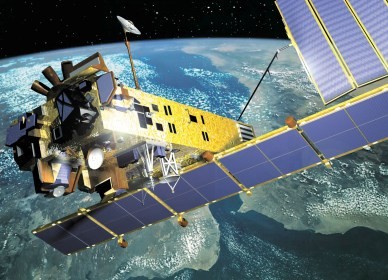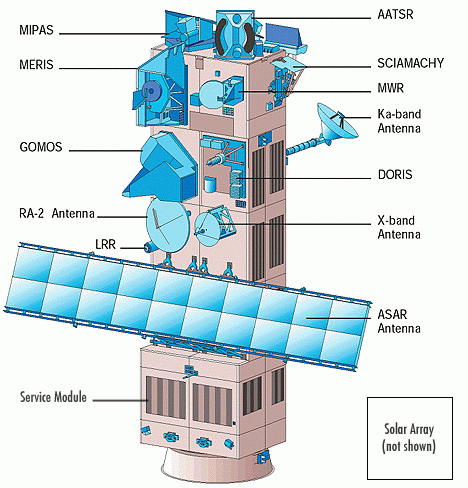Advanced Synthetic Aperture Radar (ASAR)
Source:http://www.naturalsciences.be Source: http://mtp.jpl.nasa.gov The ASAR instrument is operating at C-band and provides both continuity to the ERS-1 and ERS-2 mission SARs and next generation capabilities in terms of coverage, range of incidence angles, polarisation, and modes of operation. The resulting improvements in image and wave mode beam elevation steerage allow the selection of different swaths, providing a swath coverage more than 400km wide using ScanSAR techniques. ScanSAR is a Synthetic Aperture Radar (SAR) technique that combines large-area coverage and short revisit periods with a degraded spatial resolution compared to conventional SAR imaging modes. ASAR can provide a range of incidence angles ranging from 15° to 45° and can operate in alternating polarisation mode, providing two polarisation combinations (VV and HH, HH and HV, or VV and VH). The ASAR is onboard the EnviSat satellite, which was launched into a sun-synchronous orbit in March 2002. The exact repeat cycle for a specific scene and sensor configuration is 35 days. ASAR coverage for the SMAPEx study area is summarised in the table below. ASAR data can be downloaded from ESA.
Mission |
ASAR |
||||
Sensor |
Advanced Synthetic Aperture Radar (ASAR) |
||||
Spacecraft |
Envisat |
||||
Launch date |
1st, Mar. 2002 |
||||
Design life |
3 years with a goal of 5 years |
||||
Orbit |
Sun-synchronous polar orbit (SSO): Nominal reference orbit of mean altitude 800km, 35 days repeat cycle, 10:00am mean local solar time (MLST) descending node, 98.55°. inclination. [envisat.esa.int] |
||||
Spacecraft operations control centre |
ESA |
||||
Frequency (GHz) |
5.331 (C-band) |
||||
Mode |
Image mode |
Alternating polarisation |
Wide swath |
Global monitoring |
Wave mode |
Polarisation |
HH or VV |
HH/VV or HH/HV or VV/VH |
HH or VV |
HH or VV |
HH or VV |
Incidence angle(°) |
15~45 |
||||
Swath (km) |
<=100 |
<=100 |
>=400 |
>=400 |
5×5 (vignette) |
Spatial resolution (m) |
30 |
~30 | 150 | 1000 | 30 |
Temporal resolution |
35 days repeat cycle |
||||
ASAR overpass time
The ASAR overpass times for the SMAPEx study area have been determined from the EOLi software, and are provided in the table below. Date and time are in UTC.
●=full ASAR coverage of airborne box; ○=partial ASAR coverage
●=concurrent; ●=non concurrent
Date (UTC) |
ASAR overpass (UTC) |
ASAR mode | Polarisation | Flight Type |
| 04/12/2010 | - | - | - | ●Regional |
05/12/2010 |
●12:57 |
Global Monitoring | HH |
|
06/12/2010 |
●23:33 |
Global Monitoring | HH |
|
07/12/2010 |
- |
- | - |
|
08/12/2010 |
○12:47 |
Global Monitoring | HH |
|

